PREVIOUS
Science and Technology in Modern India - III
July 22 , 2019
2107 days
7117
0
Atomic Energy
- In March 1946, the Board of Scientific and Industrial Research (BSIR), under the Council of Scientific and Industrial Research (CSIR), set up an Atomic Research Committee under Bhabha's leadership to explore India's atomic energy resources and to suggest ways to develop and harness them.
- In June 1947, an Advisory Board for Research in Atomic Energy was established and placed under the CSIR which was chaired by Bhabha.
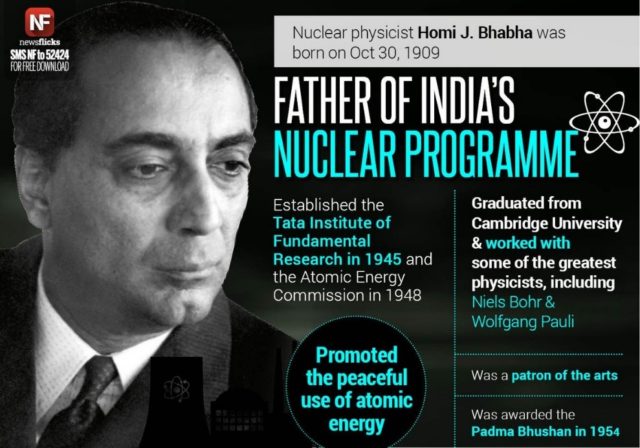
- On 23 March 1948, Prime Minister Nehru introduced the Atomic Energy Bill in the Indian Parliament and it was passed as the Indian Atomic Energy Act.
- In August 1948, the Atomic Energy Commission was established and made separate from the Department of Scientific Research, with Bhabha as its first chairman.
- A resolution passed by the Government later replaced the commission by "Atomic Energy Commission of India" on 1 March 1958 under the Department of Atomic Energy with more financial and executive powers.

- It has six research centres in India viz.
- Bhabha Atomic Research Centre (BARC)- Mumbai
- Indira Gandhi Centre for Atomic Research (IGCAR) - Kalpakkam (Tamil Nadu)
- Raja Ramanna Centre for Advanced Technology (RRCAT) - Indore
- Variable Energy Cyclotron Centre (VECC) - Kolkata
- Atomic Minerals Directorate for Exploration and Research - Hyderabad.
- Global Centre for Nuclear Energy Partnership.
- On 3 January 1954, the Atomic Energy Establishment, Trombay in Mumbai (AEET) was established by the Atomic Energy Commission.
- It aims to consolidate all nuclear reactor research and technology-related developments.
- In May 1956, construction began at Trombay on a uranium metal plant and a fuel element fabrication facility for the research reactors.
- The uranium plant came into operation in January 1959, followed by the fuel element facility in February 1960.
- The Atomic Energy Establishment Trombay (renamed the Bhabha Atomic Research Centre also knows as BARC in 1967) was formally inaugurated by Nehru in January 1957 in Mumbai.
- The Apsara nuclear research reactor at BARC was India's first nuclear reactor inaugurated in 1957. This was set up with assistance from the UK.
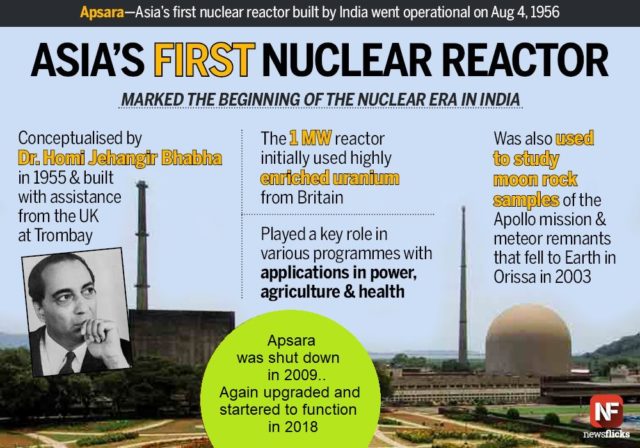
- On 28 April 1956, Nehru and the Canadian High Commissioner to India signed an agreement for a "Canada-India Colombo Plan Atomic Reactor Project".
- Under the terms of the agreement, Canada provided a 40 MW CIRUS (Canada India Reactor Utility Services) reactor at BARC for solely research purposes, including the initial manufacture and engineering of the reactor.
- It also provided technical expertise, including training Indian personnel in its operation. CIRUS was completed in early 1960 and after achieving criticality in July 1960, was inaugurated by Nehru in January 1961.
- On 11 October 1960, the Indian government issued a global tender for India's first nuclear power station near Tarapur, Maharashtra.
- It was commissioned on 28 October 1969.
- It was the first commercial nuclear power station built in India.
- Madras Atomic Power Station located at Kalpakkam is the India's first fully indigenously constructed nuclear power station.
- An Inter-Governmental Agreement on the Kudankulam Nuclear Power Plant project was signed on 20 November 1988 by the Rajiv Gandhi and the Soviet’s Mikhail Gorbachev, for the construction of two reactors.
- Construction began on 31 March 2002 and the first reactor of the plant attained criticality on 13 July 2013.
- Power generation from its first nuclear reactor started on 22 October 2013.

- India’s first nuclear weapon program was started in 1967 after Indira Gandhi came to power.
- On May 18, 1974, India conducted its first fission nuclear weapon test (Pokhran-I) known as Smiling Buddha.
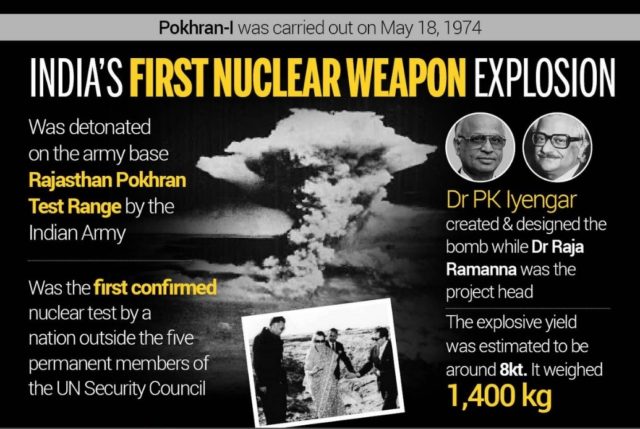
- The first fusion (Pokhran-II) weapon test was conducted on May 13, 1998.
- It consisted of five detonations, the first of which was a fusion bomb while the remaining four were fission bombs.
- The tests were initiated on 11 May 1998, under the assigned code name Operation Shakti.
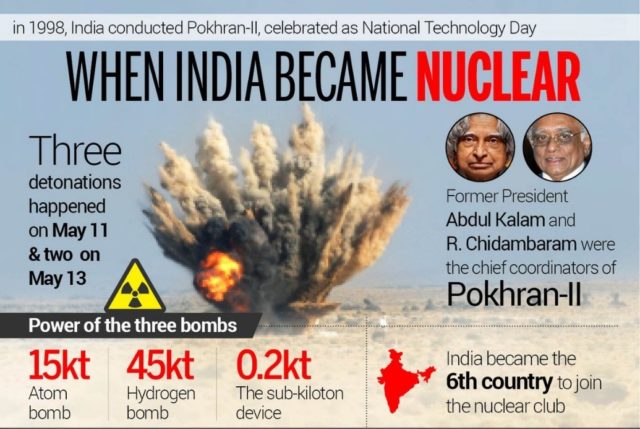
- After the tests, the many nations including United States imposed economic sanctions on India.
- The 48-nation NSG granted a waiver to India on 6 September 2008 allowing it to access civilian nuclear technology and fuel from other countries.
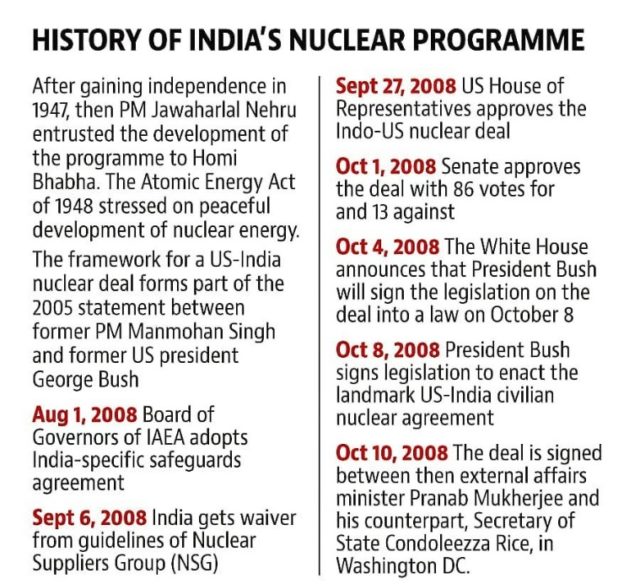
- After the Nuclear Suppliers Group (NSG) agreed to allow nuclear exports to India, France was the first country to sign a civilian nuclear agreement with India, on 30 September 2008.
- India and Mongolia signed a crucial civil nuclear agreement on 15 June 2009 for supply of Uranium to India.
- On 7 November 2009, India signed a new nuclear deal with Russia apart from the deals that were agreed upon by the two countries earlier.
- In 2014, India and Australia signed a civil nuclear agreement which allows the export of uranium to India.
- Russia has assisted in India’s efforts to design a nuclear plant for its nuclear submarine.
- India ratified Convention on The Physical Protection of Nuclear Material (CPPNM) in 2002.
- But India not yet signed the Comprehensive Test Ban Treaty (CTBT) and the Nuclear Non-Proliferation Treaty (NPT).
- Union Government has introduced Atomic Energy (Amendment) Bill, 2015 to facilitate and fast track setting up of new nuclear projects in the country.
- The Bill seeks to amend the Atomic Energy Act, 1962.
- On 27 March 2019, India and the US signed an agreement to construct 6 American nuclear reactors in India.
- As of 2018, India has signed civil nuclear agreements with around 15 countries.
- Now, Nuclear power in India is the fourth-largest source of electricity after thermal, hydroelectric, and renewable sources (of electricity).
Three-stage nuclear power programme
- In November 1954, Homi Bhabha presented the three-stage plan for national development, at the conference on "Development of Atomic Energy for Peaceful Purposes".
- Four years later in 1958, the Indian government formally adopted the three-stage plan.
- It aims to secure the country's long-term energy independence, through the use of uranium and thorium reserves found in the monazite sands of coastal regions of South India.
- India has one of the largest shares of global thorium reserves at about 25% of the world's known thorium reserves.
- India’s first indigenously developed Prototype Fast Breeder Reactor (PFBR) is at Kalpakkam in Tamil Nadu.
- In the first stage of the programme, natural uranium fuelled pressurised heavy water reactors produce electricity while generating plutonium-239 as by-product.

- In the second stage, fast breeder reactors would use a mixed oxide fuel made from plutonium-239, recovered by reprocessing spent fuel from the first stage, and natural uranium.
- Now plutonium-239 undergoes fission to produce energy, while the uranium-238 present in the mixed oxide fuel transmutes to additional plutonium-239.
- Thus, the Stage II FBRs are designed to "breed" more fuel than they consume.
- Once the inventory of plutonium-239 is built up thorium can be introduced as a blanket material in the reactor and transmuted to uranium-233 for use in the third stage.
- A Stage III reactor or an Advanced nuclear power system involves a self-sustaining series of thorium-232–uranium-233 fuelled reactors.
- This would be a thermal breeder reactor, which in principle can be refuelled – after its initial fuel charge using only naturally occurring thorium.
- As there is a long delay before direct thorium utilisation in the three-stage programme, the country is now looking at reactor designs that allow more direct use of thorium in parallel with the sequential three-stage programme.
- - - - - - - - - - - - - - -
Leave a Reply
Your Comment is awaiting moderation.


